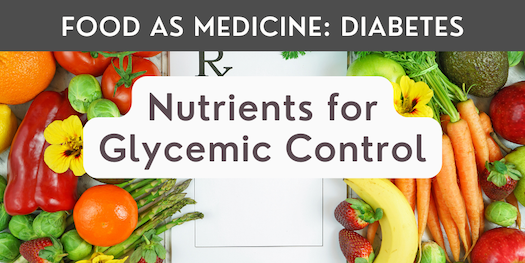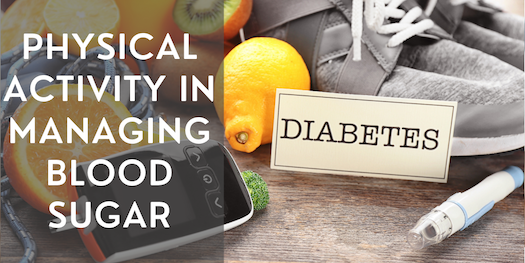November is Diabetes Awareness Month, and when it comes to diabetes management, insulin injections, pills, and carb counting typically come to mind. However, there is so much more! With the expanding and evolving science of diabetes treatment, research is pointing to a new medicine for blood sugar and insulin management: food.
Food as medicine goes beyond calories, fat, and carbohydrates, encompassing affordable, nutrient-dense, anti-inflammatory foods that align with individual needs. Using food to manage diabetes can reduce the need for medicinal treatment options and even reverse early-onset diabetes.
Foods that should be avoided are often the focus of managing diabetes, but what foods should be included in managing diabetes? Keep reading to discover foods that help improve blood sugars and more!
-Stephanie
|
|
|
Food As Medicine: Essential Nutrients for Glycemic Control
|

Extra Virgin Olive Oil (EVOO): Improving insulin sensitivity is another health benefit linked with this monounsaturated fat, olive oil. Rich in antioxidants, olive oil can help reduce inflammation, decreasing damage caused by high blood sugar levels in the body. Studies have found that people who start their day with a breakfast rich in these plant-based fats have better insulin sensitivity throughout the day.
How to eat: Drizzle EVOO over salads, vegetables, or side dishes made with whole grains, and swap out canola or vegetable oil with olive oil when cooking.
Pro tip: For maximum benefits, researchers recommend not consuming extra virgin olive oil on its own but instead in the context of a balanced diet.
Cinnamon: Rich in antioxidants, cinnamon is known for its medicinal healing properties. Cinnamon contains hydroxychalcone, which has been found to improve the body's ability to absorb sugar by stimulating insulin receptors. University of California–Davis researchers reported that about half to one teaspoon a day lowered fasting blood sugar levels in people with diabetes by an average of nine points. Please note that very high doses of cinnamon can be toxic. If you take a supplement, please consult with a registered dietitian and your physician.
How to eat: Add a dash of cinnamon to your morning oatmeal or mix it with cottage cheese, apples, and almonds as a mid-afternoon pick-me-up snack!
Pro tip: Not all cinnamon is created the same. While Cassia cinnamon is the more common because of availability and affordability, it's also higher in coumarin, which may be harmful when consumed in large amounts. The better cinnamon alternative is Ceylon, found in specialty stores.
Turmeric: Turmeric research shows that spice can lower blood sugar levels by increasing insulin sensitivity. Turmeric can stimulate insulin creation, lowering blood sugar levels and reducing the symptoms of hyperglycemia. Turmeric also helps in reducing inflammation which contributes to insulin resistance. Research has shown that turmeric has anti-diabetic effects that help lower A1c, insulin resistance, and cholesterol. Because of this, adding turmeric to the diet can help prevent developing pre-diabetes or diabetes.
How to eat: Turmeric smoothies, turmeric tea, turmeric stir-fry, or curry
Pro tip: Before taking a turmeric supplement, talk with your healthcare team, especially if you are taking medication for diabetes.
Protein: Protein is an essential nutrient for growth, maintenance, energy, and the body's chemical reactions. Protein is vital in making hormones like insulin and glucagon that regulate the body's blood sugar level. When pairing protein with a carbohydrate source, your body will take longer to convert carbs into glucose, reducing the chance of a blood sugar spike. In addition, having a protein source with carbs will keep you full.
How to eat: Balance meals with small amounts of protein, including eggs, yogurt, beans, chicken, and fish.
Pro tip: If you have any health conditions (such as kidney disease) that limit protein intake, talk with your doctor about how much protein you should consume.
Fiber: Fiber can improve blood sugar control because the body does not absorb or break down the nutrient. Because fiber is not digested, it does not spike the body's blood sugar. Fiber is another nutrient that will make you feel fuller longer. Reading food labels is the best way to determine foods containing fiber.
How to eat: Increase your intake of plant-based foods such as fruits, vegetables, nuts, whole grains, and beans.
Pro tip: Start your day with steel-cut oats or classic rolled oats! Studies have found that eating oats and other fiber-rich foods for breakfast appears to help keep blood glucose under control throughout the day.
|
|
|
Physical Activity in Managing Blood Sugar
|

Regular exercise is essential in managing blood sugars for diabetes or pre-diabetes. Physical activity makes your body more sensitive to insulin, lowering blood sugar. Additional benefits to physical activity are controlling your blood pressure, sleeping better, improving your memory, and feeling happier. Ways to get started exercising include starting small, finding something you like, exercising with a partner, make goals. It is essential to stay hydrated by drinking plenty of fluids while physically active.
- Start small: Begin slowly with light exercise and build your way up to your desired goal. Starting small can mean taking the stairs, parking further from the store entrance, doing yard work, or even walking up and down the driveway at home.
- Find something you like: Choosing an exercise you enjoy will help you look forward to regular movement instead of it being a chore. It will help to be a behavior you stick with if you like doing the exercise.
- Exercise with a partner: Having a partner to hold you accountable and motivate you can help you stay consistent with exercise. Doing exercise with a partner can be more enjoyable and less tedious than doing it alone.
- Make goals: Make achievable goals to work towards to monitor progress and be proud of yourself.
|
|
Featured Recipe
Roasted Vegetable Pasta with California Avocado Pesto Sauce
|
Recipe by: California Avocado
Roasted Vegetables
- 2 (5-inch) zucchini, halved and sliced into 1/2-inch slices
- 2 (6-inch) carrots, sliced into 1/2-inch slices
- 12 Brussels sprouts, halved
- Nonstick cooking spray
Pasta
- 8 oz. rotini high protein and fiber dry pasta
- 1 cup cherry tomatoes, halved
- 1 ripe, Fresh California Avocado, seeded, peeled, and cut into 1-inch cubes
- For the Avocado Pesto Sauce
- 1 ripe, Fresh California Avocado, seeded, peeled, and cubed
- 1 bunch basil leaves, reserve a few leaves for garnish if desired
- 1/2 cup 2% plain Greek yogurt
- 1/4 cup shredded Parmesan cheese
- 1/4 tsp. black pepper
- 1/2 tsp. sea salt
- 1/4 cup water
Instructions
- Preheat the oven to 450 F.
- Cover a large 17¼-inch-by-11½-inch-by-1-inch baking sheet with aluminum foil and spray the foil with nonstick cooking spray.
- Put the vegetables on the sheet and roast them for 25 minutes or until they are tender and their edges are browned.
- In the meantime, bring a large pot of water to a boil. Cook pasta according to package instructions until al dente. Drain and set aside.
- In a blender, add all the ingredients for the avocado pesto sauce and blend until reaching a creamy smooth consistency.
- In a large bowl, add the cooked pasta and stir in half of the avocado pesto sauce. Divide the pasta among serving dishes and top with roasted vegetables, cherry tomatoes, and avocado. Drizzle with additional sauce and help with the remaining sauce on the side. Store any remaining sauce in an airtight container and refrigerate.
Suggestion: Serve with grilled or baked chicken breast.
Makes 4 servings
Nutrition Facts: Calories: 380 cal, 12 grams fat, 2.5 grams saturated fat, 6 grams monounsaturated fat, 5 mg cholesterol, 310 mg sodium, 59 grams carbohydrates, 13 grams fiber, 15 grams protein
|
|
|
Be Inspired
|
|

|
|
|
About SO Nutrition
|
 Stephanie Leipprandt Ouellette, MBA, RDN, LD
Stephanie Leipprandt Ouellette, MBA, RDN, LD Stephanie has been working in the field of nutrition and dietetics since 1995. She earned a Bachelor of Science degree in Dietetics from Michigan State University, completed an Approved Pre-Professional Practice Program at Western Michigan University and earned a Master of Business Administration from Baker College. She’s been a Registered Dietitian Nutritionist since 1996 and licensed in Texas since 2007. In 2008, Stephanie earned her certification in Childhood and Adolescent Weight Management. Stephanie has extensive clinical & managerial experience, both in corporate settings and in the community. Now she wants to share her knowledge with you, because most (if not all) nutritional habits begin at home.
Stephanie and her family reside in Katy, Texas
|
|
| |
Copyright © 2022 Customized Nutrition Newsletters, All rights reserved.
|
|
| |
|
|